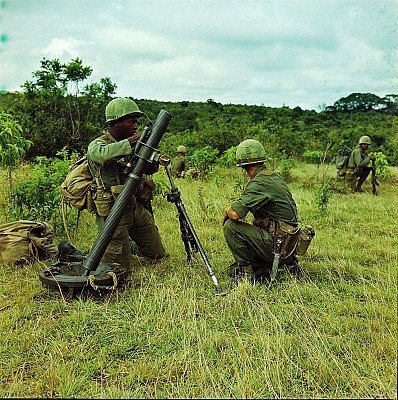RARE! 1962 Vietnam War “81MM MORTARS” MARINE CORPS SCHOOL Quantico Virginia Training Manual*



















RARE! 1962 Vietnam War “81MM MORTARS” MARINE CORPS SCHOOL Quantico Virginia Training Manual*
Comes with a hand-signed C.O.A.
This rare and museum-grade Vietnam War artifact was used at the infamous MARINE CORPS SCHOOL at Quantico, Virginia to train US Marines on “81MM MORTARS”. Dated 1962 this detailed Vietnam War manual was produced in very limited quantities and was used to teach Marines how to use the 81mm mortar in combat.
The Vietnam War, one of the most contentious and prolonged conflicts of the 20th century, featured a wide array of weaponry and equipment used by both the United States and North Vietnamese forces. Among these weapons, the U.S. 81mm mortar played a pivotal role in the conflict, proving to be a versatile and effective tool in the hands of American troops.
The U.S. 81mm mortar had its origins in the early 20th century when military forces worldwide recognized the need for portable and powerful indirect fire support. The concept of a mortar, which could launch explosive shells at a high angle to reach targets behind obstacles or in trenches, was refined and developed over several decades. By the time of the Vietnam War in the 1960s and 1970s, the U.S. military had adopted the M29 81mm mortar as its standard infantry mortar.
Technical Specifications
The U.S. 81mm mortar, known for its portability and firepower, had several key technical specifications that made it an essential asset in combat:
Caliber and Range: The mortar featured an 81mm caliber barrel, allowing it to fire shells with a range of up to 4,800 meters, making it ideal for supporting infantry troops operating in jungle terrain in Vietnam.
Portability: Weighing around 45 pounds, the 81mm mortar was relatively lightweight and could be carried by a small crew. This portability was crucial for mobility in the dense and challenging terrain of Vietnam.
Ammunition: The mortar fired various types of ammunition, including high-explosive rounds, illumination rounds, and smoke rounds. The versatility in ammunition types allowed it to fulfill a range of combat roles.
Rate of Fire: The U.S. 81mm mortar had an impressive rate of fire, capable of launching up to 30 rounds per minute when operated by a well-trained crew.
Accuracy: Despite being an indirect fire weapon, the mortar's accuracy was enhanced by its sighting system, which included a baseplate, bipod, and aiming stakes.
Tactical Utility
The U.S. 81mm mortar's tactical utility during the Vietnam War was multifaceted, contributing significantly to the success of American forces:
Fire Support: The mortar provided critical fire support to infantry units, enabling them to engage enemy positions that were out of direct line of sight. This indirect fire capability was vital in countering guerrilla tactics employed by North Vietnamese forces.
Mobility: Its relatively lightweight design allowed it to be rapidly deployed and repositioned as the situation on the battlefield evolved. This mobility was crucial in the fluid and dynamic nature of combat in Vietnam.
Versatility: The ability to fire different types of ammunition made the 81mm mortar adaptable to various combat scenarios. High-explosive rounds were used for enemy positions, illumination rounds for night operations, and smoke rounds for concealing troop movements.
Suppression and Harassment: The mortar could effectively suppress and harass enemy positions, keeping the enemy forces at bay and disrupting their operations.
Counterbattery Fire: American mortar crews often used their weapons to engage and neutralize enemy mortar positions, providing protection for their own troops.
Impact on the Vietnam War
The U.S. 81mm mortar had a significant impact on the outcome of the Vietnam War:
Infantry Support: It provided essential support to infantry units, allowing them to maneuver more effectively and engage the enemy with indirect fire.
Counterinsurgency: In a conflict characterized by guerilla warfare and hidden enemy positions, the mortar's ability to deliver indirect fire proved invaluable in rooting out hidden threats.
Psychological Warfare: The mortar's thundering explosions and the ability to deliver illumination and smoke rounds played a psychological role in the conflict, demoralizing the enemy and boosting the morale of American troops.
Flexibility: The mortar's versatility allowed it to be used in various roles, enhancing the adaptability of American forces in a challenging and unfamiliar environment.
The U.S. 81mm mortar was a crucial asset for American forces during the Vietnam War. Its technical specifications, portability, and versatility made it an effective weapon in the dense jungles of Vietnam. With the ability to provide indirect fire support, mobility, and a range of ammunition options, the 81mm mortar contributed significantly to the tactical success of American troops in the conflict. Its impact extended beyond the battlefield, playing a role in the psychological aspect of warfare. Overall, the U.S. 81mm mortar proved itself as an indispensable tool in the hands of American forces during one of the most challenging conflicts in modern history.